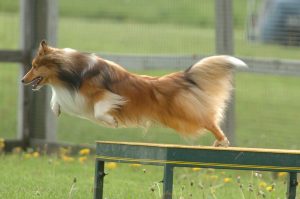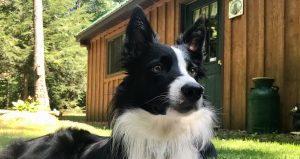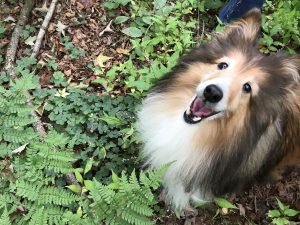
The Release Word – the first step toward impulse control
 This is the first in a series of posts that explore the “little things” that lead to big improvements in agility AND your relationship with your dog.
This is the first in a series of posts that explore the “little things” that lead to big improvements in agility AND your relationship with your dog.
In this post, I’m going to make the case that teaching a verbal release word is one of the first things you should teach your puppy and is critical to building impulse control and therefore teaching stationary behaviors like a sit-stay or independent stop on a contact.
When do I start?
Right away! When I bring a puppy home and know its comfortable in its new environment, we play games that include a lot of physical play and tons of reinforcement with food, toys and interaction with me. During these play sessions I introduce my release word. Usually it goes like this…play, play, play…PAUSE. Wait for a behavior….Often the puppy will sit but it’s ok if the puppy just pauses too. I then immediately say the word (without moving) and immediately re-engage with the puppy. As I build on those experiences and get the puppy to offer stationary behaviors like sit, down, stand, stay in crate, wait at door, etc., I consistently use my release word. I choose a word that I don’t use often in everyday life. For a while now, I’ve used the word “Break” and it seems to work well. But any word that isn’t used often in everyday speech and doesn’t sound like your other planned verbal skills will work.
For a very young puppy, the “wait for release” might be just a second or two. But the experience of and reinforcement for choosing to wait until the verbal cue is given is HUGE! Once the word is given and the puppy “breaks”, it is immediately reinforced with a cookie, a chase game, engagement with the toy or other fun activity. That’s right…the puppy is rewarded for “breaking” but ONLY when it hears the magic word! This is great practice for building impulse control!
The release word is a verbal cue
Verbal cues are all the rage in agility these days. Do you think of your release word as a verbal cue? You should! A release word is the first verbal cue I teach my puppies and as with other verbal cues, I work toward building an understanding of the cue independent of my motion or other physical cues. After all, on an agility course I need to be moving while the dog is stationary as I lead out or run past the dog who has stopped at the end of the contact. I can make a case that if you are going to teach – and proof – just one verbal cue, the release word should be it. Other than the dog’s name of course!
Why is teaching verbal cues so hard? Dogs are naturally way more tuned into physical cues and motion than they are to verbal cues. Without a clear understanding of the verbal release cue, the dog will be looking for ANY physical cue to end the stationary behavior. You might imagine the dog guessing…Do I leave when she takes a step? Can I leave when she flicks her hand? When she leans away? When she stops and then starts again? The tension builds the longer this guessing game goes on until the dog is shifting around or breaking his stay. It is **very** important that you do not consistently pair physical motion with your verbal release cue. At first, isolate the release word from any motion, then add “nonsense” motion to help the dog understand that the release is on the WORD, not the motion. It is a good idea to video some of your training sessions so you can verify that you have isolated the verbal cue.
Not having a well understood verbal release cue makes it very difficult to put any kind of duration or independence on stationary behaviors like a sit-stay or target behavior on contacts, no matter how often you reward in place. For some high-drive dogs, it makes it almost impossible. For softer dogs, the confusion of not knowing when to leave takes a little bit of their spark away.
What about rewarding in place?
When building duration in stationary behaviors I will reward in place but I’m careful to maintain the understanding that the behavior ends when I give the verbal release cue, not when I stop delivering cookies.
More than one release cue?
You can definitely have more than one release cue. My release word means – end the current behavior and come to me OR do the next behavior that I’ve cued. As I add other well trained verbal cues, I can use them as release cues. “Get it” – to release to a toy; or “Down” from a “Sit”. Or cue an obstacle like a jump (“Hup”) or “Tunnel” from the start line or a stopped contact.
Keep the game going
I like playing little games with my dogs into their adulthood that incorporate foundation skills. These games are engaging, low impact and reinforce necessary skills. I’ve included a short session with Nick at the link below. Here, I apply a mental model I call the “Even When” game. Can Nick maintain his sit or down stay and wait for the verbal release even when I am flapping my arms? Even when I stop and start again in my lead-out? Even when I give a different word? Even when I run hard? Even when I throw a ball in front of his face? As a mature dog, Nick is pretty good at this game. For a puppy, the “even when” criteria are introduced gradually, allowing the pup to be “mostly” successful. A little failure is necessary to learning, after all!
I’d love to hear your thoughts on this topic! Does it make sense? Do you think this approach could help your dog develop impulse control more easily and streamline your training?
Happy Training!



